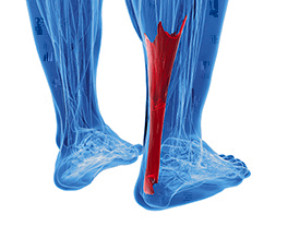 The largest tendon in the body is known as the Achilles tendon. Its function is to connect the heel bone to the calf muscles. Many tendons in the body are not flexible, and it is important to properly stretch this tendon before engaging in a sporting activity. If it should become irritated and inflamed, the result may be an Achilles tendon injury. The symptoms that are often associated with this type of injury can include tenderness, severe pain, discomfort, and the inability to bend the foot downward. If this tendon is not properly stretched, many people could tear their Achilles tendon if they start a new exercise regime, or increase the intensity considerably. There are numerous treatment options for this type of injury. If you feel you have injured your Achilles tendon, it is advised to consult with a podiatrist who can guide you toward the best treatment option.
The largest tendon in the body is known as the Achilles tendon. Its function is to connect the heel bone to the calf muscles. Many tendons in the body are not flexible, and it is important to properly stretch this tendon before engaging in a sporting activity. If it should become irritated and inflamed, the result may be an Achilles tendon injury. The symptoms that are often associated with this type of injury can include tenderness, severe pain, discomfort, and the inability to bend the foot downward. If this tendon is not properly stretched, many people could tear their Achilles tendon if they start a new exercise regime, or increase the intensity considerably. There are numerous treatment options for this type of injury. If you feel you have injured your Achilles tendon, it is advised to consult with a podiatrist who can guide you toward the best treatment option.
Achilles tendon injuries need immediate attention to avoid future complications. If you have any concerns, contact Dr. Steven Sheridan of Ankle & Foot Specialty Clinics. Our doctor can provide the care you need to keep you pain-free and on your feet.
What Is the Achilles Tendon?
The Achilles tendon is a tendon that connects the lower leg muscles and calf to the heel of the foot. It is the strongest tendon in the human body and is essential for making movement possible. Because this tendon is such an integral part of the body, any injuries to it can create immense difficulties and should immediately be presented to a doctor.
What Are the Symptoms of an Achilles Tendon Injury?
There are various types of injuries that can affect the Achilles tendon. The two most common injuries are Achilles tendinitis and ruptures of the tendon.
Achilles Tendinitis Symptoms
- Inflammation
- Dull to severe pain
- Increased blood flow to the tendon
- Thickening of the tendon
Rupture Symptoms
- Extreme pain and swelling in the foot
- Total immobility
Treatment and Prevention
Achilles tendon injuries are diagnosed by a thorough physical evaluation, which can include an MRI. Treatment involves rest, physical therapy, and in some cases, surgery. However, various preventative measures can be taken to avoid these injuries, such as:
- Thorough stretching of the tendon before and after exercise
- Strengthening exercises like calf raises, squats, leg curls, leg extensions, leg raises, lunges, and leg presses
If you have any questions please feel free to contact our office located in Sandusky, MI . We offer the newest diagnostic tools and technology to treat your foot and ankle needs.
